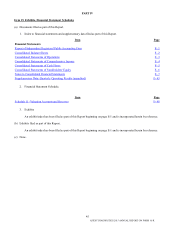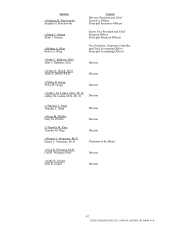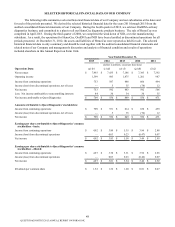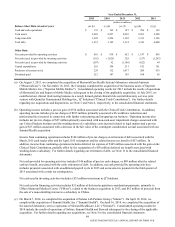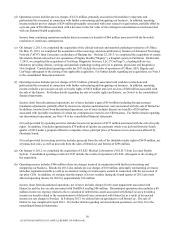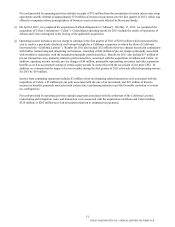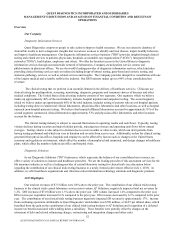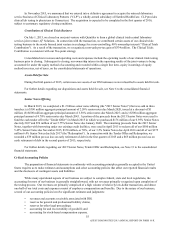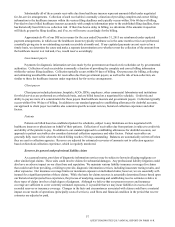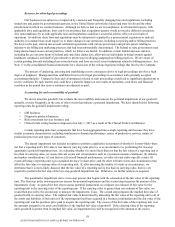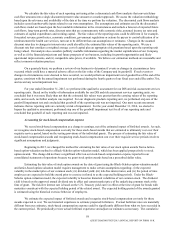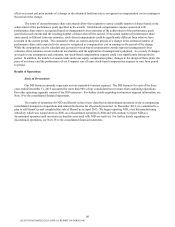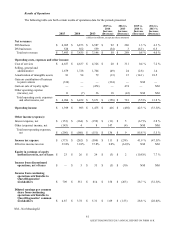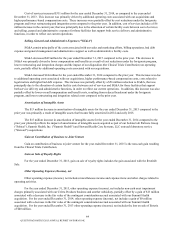Quest Diagnostics 2015 Annual Report Download - page 58
Download and view the complete annual report
Please find page 58 of the 2015 Quest Diagnostics annual report below. You can navigate through the pages in the report by either clicking on the pages listed below, or by using the keyword search tool below to find specific information within the annual report.54
our customers and payers has continued. Consolidation is increasing price transparency and bargaining power, and
encouraging internalization of clinical testing.
For additional information on our key trends, see Item 1: "The United States Clinical Testing Industry."
Operational Excellence
Invigorate Program
The clinical testing industry is labor intensive. Employee compensation and benefits constitute approximately one-
half of our total costs and expenses. In addition, performing clinical testing involves significant fixed costs for facilities and
other infrastructure required to obtain, transport and test specimens. Therefore, relatively small changes in volume can have a
significant impact on profitability in the short-term.
We are engaged in a multi-year program called Invigorate, which is designed to reduce our cost structure. We
delivered more than $700 million in run-rate savings as we exited 2014. In November 2014, we announced our goal to deliver
an additional $600 million in run-rate savings as we exit 2017. Achieving this goal would bring the total savings from the
Invigorate program to $1.3 billion in run-rate savings, compared to 2011. In 2015, we delivered realized savings of more than
$200 million and believe we are on track to achieve our $1.3 billion run-rate savings goal by the end of 2017.
Invigorate has consisted of several flagship programs, with structured plans in each, to drive savings and improve
performance across the customer value chain. These flagship programs include: organization excellence; information
technology excellence; procurement excellence; service excellence; lab excellence; and billing excellence. In addition to these
programs, we identified new key opportunities to change how we operate in order to meet our goal of delivering the additional
$600 million in run-rate savings as we exit 2017. These new key opportunities include: standardizing our processes,
information technology systems, equipment and data; enhancing electronic enabling services; and enhancing reimbursement for
work we perform. We believe that our efforts to standardize our information technology systems, equipment and data also will
foster our efforts to restore growth and support the value creation initiatives of our clinical franchises by enhancing our
operational flexibility, empowering and enhancing the customer experience, facilitating the delivery of actionable insights and
bolstering our large data platform.
In January 2015, we adopted a course of action related to this multi-year program. We developed a high-level estimate
of the total pre-tax charges expected to be incurred in 2015 through 2017 in connection with the course of action for the program:
$300 million. In February 2016, we developed high-level estimates of the pre-tax charges expected to be incurred in connection
with the course of action for 2016 totaling $80 million to $100 million, consisting of up to $10 million of employee separation
costs and $80 million to $90 million of systems conversion and integration costs. As detailed plans to implement the course of
action are approved and executed, it will result in charges to earnings. Principally all of the total estimated pre-tax charges expected
to be incurred in 2016 are anticipated to result in cash expenditures. The actual charges incurred in connection with the course of
action in 2016 could be materially different from these estimates.
From 2012 through 2014, the cumulative charges recorded in connection with the Invigorate program were $266
million, including $178 million of cumulative pre-tax employee separation costs and other restructuring related costs. During
2015, the cumulative charges recorded in connection with the 2015 course of action were $89 million, including $39 million of
cumulative pre-tax employee separation costs and other restructuring related costs.
For further details regarding restructuring costs related to the Invigorate program, see Note 4 to the consolidated
financial statements.
Recent Transactions
Acquisitions
In 2015, we acquired MemorialCare Health System's laboratory outreach business and the business assets of Superior
Mobile Medics, a national provider of paramedical and health data collection services to the life insurance and employer health
and wellness industries. For details regarding our acquisitions, see Note 5 to the consolidated financial statements.
QUEST DIAGNOSTICS 2015 ANNUAL REPORT ON FORM 10-K



